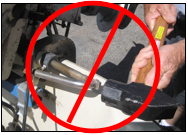Try a littler harder - still won’t turn.
Really put some muscle into it - the engine turns with some effort, or it spins easily, but the motor doesn’t change position.
This is a description of one of the most common problems related to steering on outboard applications. What happens is the steering tube on the motor is made of iron, and it rusts on the inside. There is very small clearance between the tube and the portion of the cable that passes through it. The tube rusts and the cable is stuck. (Most hydraulic systems do not have parts that move inside the steering tube, so most of the following does not apply to hydraulic systems.)
Once the cable binds up, there is often little that can be done short of replacing or removing the cable, cleaning the tube, and applying good corrosion control grease.
The other major cause of the tight steering might be tightness between the engine mounting bracket and the vertical shaft, which the engine rides and turns upon. Once the rod that connects the steering cable to the engine is removed, try turning the engine by hand to see if it turns freely. Regular application of grease to the fittings on the engine will usually prevent stiffness in this connection. If this turns out to be the problem, it may be a bigger job than you want to tackle. Refer to the repair manual for your engine for necessary steps.
How to remove the cable from an outboard tube

1. Disconnect from the part of the engine that turns.
2 Unscrew steering cable nut from steering tube.
3 Now the hard part:

a. Depending on the boat setup, it is sometimes necessary to un-bolt the engine from the transom.
b. Do not hammer on the port end of the cable shaft, hoping to back it out. There is a 5/16” hole near the end of the cable shaft and even a small impact from a hammer will expand the cable shaft and lock the two parts together.
c. Work penetrating oil between the parts and gently tap the cable shaft, which may start it moving.
4. Depending on the boat setup, it is sometimes necessary to un-bolt the engine from the transom.
5. Do not hammer on the port end of the cable shaft, hoping to back it out. There is a 5/16” hole near the end of the cable shaft and even a small impact from a hammer will expand the cable shaft and lock the two parts together.
6. Work penetrating oil between the parts and gently tap the cable shaft, which may start it moving.
Fix it:
1. The stresses placed on the steering system by the stuck shaft may permanently damage the cable or steering head. After all the energy expended in removing the cable, it may be smart to replace the entire steering system.
2. If you are not replacing steering:
a. Make sure the tube is very clean and free of rust.
b. Grease end of cable thoroughly with a good marine grease like the one used on trailer bearings.
c. Re-assemble…
3. Boathouse offers the “top of the line” U-flex cable steering package for $159.95. This package provides everything you need to update your steering in one kit. Mention this email, and receive $5.00 off the kit, for $154.95.
4. Follow instructions that come with kit to install new kit.
If this project sounds like more than you want to tackle, the Boathouse service department in Melbourne can do the job for you. In the Jacksonville area, there are many good service firms that you can use. The Jacksonville Boathouse staff can recommend one.
Happy Boating!
Chuck
